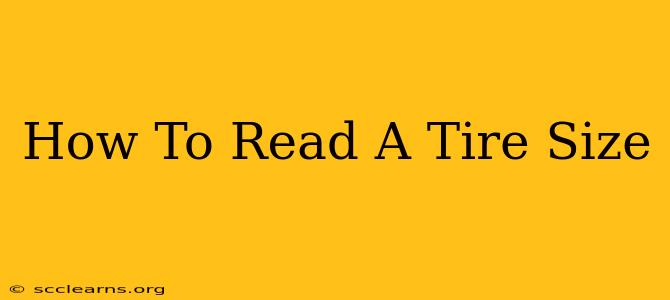Understanding your tire size is crucial for safe driving and proper vehicle maintenance. Knowing how to decipher those seemingly cryptic numbers and letters on your tire sidewall empowers you to make informed decisions about tire replacements and ensures you're driving on the right tires for your vehicle. This guide breaks down exactly how to read a tire size, explaining each component and what it means.
Decoding the Tire Size Code: A Step-by-Step Approach
Let's use a common tire size as an example: P215/65R15 95H. We'll dissect each part to understand its significance.
1. Aspect Ratio: The Height-to-Width Ratio
- P: This indicates the tire is a passenger car tire. Other designations include LT (light truck) and ST (special trailer).
- 215: This is the tire width in millimeters. This refers to the distance across the tire from sidewall to sidewall. A wider number means a wider tire.
- 65: This is the aspect ratio, expressed as a percentage. It represents the tire's sidewall height as a percentage of its width. In our example, 65 means the sidewall height is 65% of the 215mm width (65% of 215mm = 139.75mm). A lower aspect ratio (e.g., 55) means a shorter, wider, and potentially sportier tire, while a higher aspect ratio (e.g., 75) means a taller, narrower, and often more comfortable tire.
2. Construction Type: Radial or Bias-Ply
- R: This indicates the tire is a radial tire, the most common type used in passenger vehicles today. Radial tires have the plies of the tire running radially (straight across) from the bead to the center.
3. Wheel Diameter: The Rim Size
- 15: This is the wheel diameter in inches. This is the size of the wheel rim that the tire fits onto. This number is crucial for compatibility – you must choose a tire with a wheel diameter that matches your car's rims.
4. Load Index: Weight Capacity
- 95: This is the load index. This number refers to the maximum load the tire can carry at its maximum inflation pressure. You can find a chart that converts the load index number to kilograms or pounds in your vehicle owner's manual or online.
5. Speed Rating: Maximum Speed
- H: This is the speed rating. This letter indicates the maximum speed the tire is rated for. Again, a chart is needed to understand the speed in kilometers per hour (km/h) or miles per hour (mph). For example, H typically corresponds to 130 mph. Different speed ratings are represented by different letters (e.g., V, W, Y).
Why Understanding Tire Size Matters
Knowing your tire size is important for several reasons:
- Safety: Using the incorrect tire size can compromise your vehicle's handling, braking, and stability.
- Fuel Efficiency: The wrong tires can negatively impact your fuel economy.
- Vehicle Warranty: Using non-compliant tires can void parts of your vehicle's warranty.
- Performance: Tire size directly affects your vehicle's ride comfort, handling, and overall performance.
Finding Your Tire Size Information
Your tire size is typically printed on the sidewall of each tire. You can also find it:
- In your vehicle owner's manual: This is usually the most reliable source.
- On the driver's side doorjamb: A sticker often displays the recommended tire size.
- On the tire placard: Located somewhere in your vehicle, often in the glove compartment or on the driver's side doorjamb, usually contains a tire and pressure placard.
By following these steps, you can confidently decipher your tire size and make informed decisions about maintaining and replacing your tires. Remember, choosing the correct tires is essential for safety and optimal vehicle performance.

